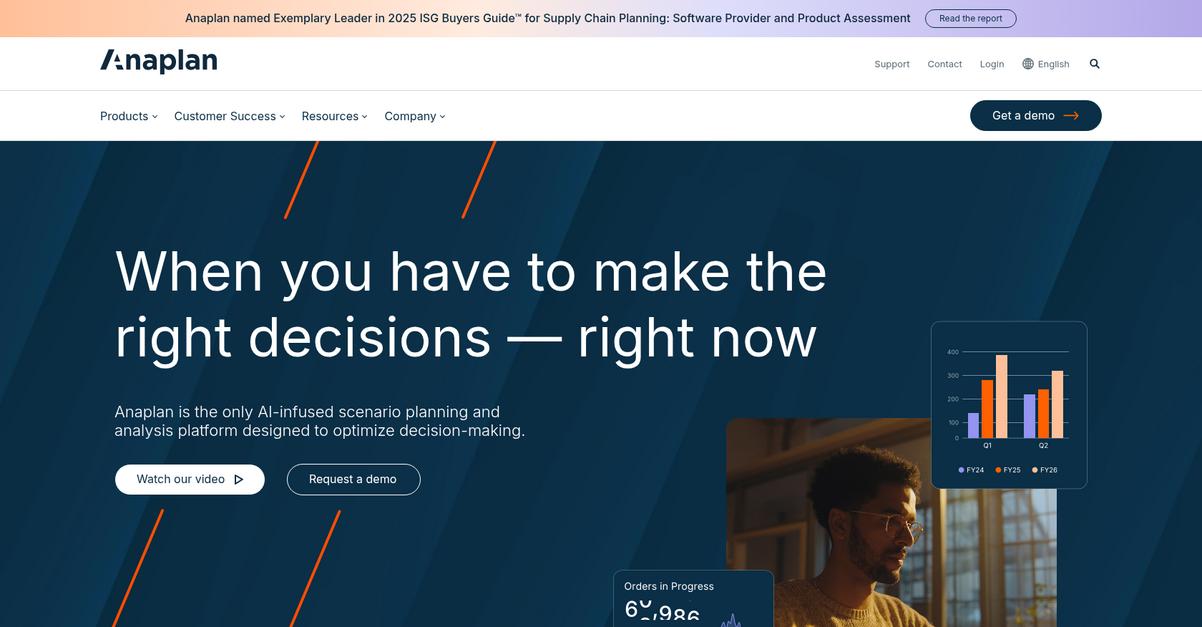Are your financial forecasts missing the mark?
When you’re stuck with messy spreadsheets, your financial planning feels more like guesswork than a reliable strategy for long-term growth.
The pressure is immense. A single inaccurate forecast can derail budgets, leading to missed opportunities and very tough questions from your leadership team.
Forecastio reports that companies with accurate forecasts are 10% more likely to achieve revenue growth year-over-year. This highlights the very real opportunity cost of relying on unreliable financial modeling.
The good news is the right software can eliminate this forecasting guesswork, giving you the confidence to make solid, data-driven decisions.
If you’re also exploring software solutions, my article on best audience response software covers how to gather real-time data.
In this guide, I’ll walk you through my picks for the best financial analytics software designed to boost your accuracy and finally automate reporting.
You’ll discover tools that replace tedious manual work and provide the predictive insights you need to stay ahead of the competition.
Let’s get started.
Quick Summary:
| # | Software | Rating | Best For |
|---|---|---|---|
| 1 | ThoughtSpot → | Enterprise financial teams | |
| 2 | Tableau → | Data-driven enterprises | |
| 3 | Anaplan → | Financial analysts at scale | |
| 4 | Datarails → | Mid-sized finance teams | |
| 5 | Board → | Enterprise planners |
1. ThoughtSpot

Struggling with financial forecasting accuracy and compliance?
ThoughtSpot directly addresses this by offering an Agentic Analytics Platform, empowering you to generate real-time, actionable insights for your financial data. This means you can swiftly move from complex data to clear financial decisions.
Their new Spotter, your dedicated AI Analyst, gives you business-ready insights and answers your questions, delivering enterprise-grade trust in your financial reporting. This allows you to modernize reporting without compromising compliance.
Here’s how to gain competitive insights.
ThoughtSpot transforms insights into actions with autonomous workflows, seamlessly connecting data to decision-making. You can embed AI analytics directly into your custom apps, empowering your teams with customized actions and writebacks.
This platform lets you easily prep, join, model, and shape your financial data—whether real-time or cached—any way you want, integrating with existing systems like Google BigQuery, Snowflake, and Amazon Redshift. Their Analyst Studio provides powerful tools like SQL, R, and Python, accelerating your team’s ability to turn data into insights and supporting granular compliance tracking.
You can also leverage AI-augmented dashboards to bring financial insights to life with interactive, endlessly-drillable visualizations, gaining a deeper understanding of underlying sales growth and turnover. This helps achieve enhanced financial planning accuracy and reduces manual data processing.
Get audit-ready reporting, fast.
Key features:
- AI Agents: Autonomous AI agents, like Spotter, provide true self-service analytics, answering questions and delivering trusted, business-ready insights on demand.
- Analyst Studio: This collaborative creator space equips your data teams with powerful tools including SQL, R, and Python for accelerated data-to-insight workflows and visual analysis.
- Any Data, Anywhere: Connects, preps, joins, and models your financial data from diverse sources (e.g., Google BigQuery, Snowflake), whether real-time or cached, for comprehensive analysis.
Learn more about ThoughtSpot features, pricing, & alternatives →
Verdict: ThoughtSpot’s focus on AI-powered self-service and actionable insights, coupled with powerful data integration and analyst tools, makes it an excellent choice for financial teams aiming for enhanced forecasting accuracy and audit-ready reporting, standing out as a leading best financial analytics software.
2. Tableau

Struggling with complex financial data and manual reporting?
Tableau helps you turn trusted insights into autonomous action, giving you the power to see, understand, and act on your financial data.
You can transform how you use data to solve problems, making your team more data-driven and improving financial planning accuracy.
This means you can make data-driven decisions.
Tableau’s visual analytics platform empowers you to ask questions of your data without getting bogged down by complex software. You can connect to all your data with fully integrated AI/ML capabilities, governance, and data management.
This platform provides limitless data exploration without interrupting your flow of analysis, helping you achieve predictive forecasting and automated reporting. You can deploy it in the cloud, on-premises, or natively integrate it with Salesforce CRM, ensuring audit-ready reporting and competitive insights.
The result is increased efficiency and enhanced financial planning accuracy.
While we’re discussing data management, understanding data governance policies is equally important for compliance and clarity.
Key features:
- Agentic Analytics Platform: Fuel faster data, insights, and action by turning trusted insights into autonomous action, built on Salesforce and integrated with Agentforce.
- Trusted AI Assistant: Accelerate data-driven decisions with conversational AI, making data preparation and visualization faster, now available with Tableau +.
- Intuitive Visual Analysis: Explore data without interrupting your flow, transforming how your team uses data to solve problems and be more data-driven.
Learn more about Tableau features, pricing, & alternatives →
Verdict: Tableau provides an intuitive, AI-powered visual analytics platform that directly addresses financial analysts’ needs for predictive forecasting and automated reporting. Its ability to turn trusted insights into autonomous action makes it an excellent choice for best financial analytics software, as demonstrated by JLR delivering £250M in business value.
3. Anaplan

Struggling with financial forecasting and accurate reporting?
Anaplan’s AI-infused platform helps you transform consolidation, reporting, and planning, ensuring you make optimized decisions at the speed of business. This means you can pivot and adapt to market changes while minimizing risk.
This is crucial for financial analysts dealing with complex data and compliance pressures, as it helps you move at market speed.
Here’s how Anaplan helps.
Anaplan is designed to optimize decision-making, offering solutions for integrated financial planning, financial consolidation, and disclosure management. You can get precise, predictive insights quickly across your organization with features like Anaplan Intelligence. Furthermore, the platform offers data management and integrations to connect planning data from any source. Additionally, Anaplan Coplaner provides connected, context-aware generative-AI capabilities to help you explore patterns and act on insights. This allows you to outpredict, outplan, and outperform your competition.
The result is enhanced financial planning accuracy and audit-ready reporting.
Key features:
- AI-infused scenario planning: Provides precise, predictive insights for optimizing decision-making across your business, helping you stay ahead of market trends.
- Data management & integrations: Allows you to connect and integrate planning data from any source, breaking down silos and ensuring comprehensive financial analysis.
- Integrated financial applications: Includes purpose-built applications like Integrated Financial Planning, Financial Consolidation, and Disclosure Management to streamline your financial operations.
Learn more about Anaplan features, pricing, & alternatives →
Verdict: Anaplan excels as a leading best financial analytics software by leveraging AI-infused capabilities for precise, predictive insights. It helps eliminate data silos, enabling seamless integration of financial, operational, and strategic plans, which can lead to a 14% improvement in Total Shareholder Return. This focus on connected planning, data management, and industry-tailored solutions directly addresses the pain points of financial analysts seeking enhanced forecasting accuracy and compliance.
4. Datarails

Struggling with complex financial data and manual reporting?
Datarails helps you automate repetitive FP&A processes while retaining your preferred Excel environment. This means you can integrate with popular accounting software, ERPs, and CRMs.
This allows for automated data consolidation and reporting, giving you more time to focus on strategic insights. The result is your ability to leverage existing Excel models with enhanced power.
Unlock actionable financial insights.
Datarails’ FinanceOS allows you to continue working in Excel with full functionality, while automating tasks like consolidation and reporting. This frees you to dive deeper into financial and operational data for analysis, from variance drivers to sales performance.
Their AI-powered FP&A Genius provides conversational AI, delivering quick answers to burning questions based on your consolidated financial data across the company. Additionally, the platform streamlines financial close by automating P&L, balance sheet, and cash flow statement preparation, helping you ensure audit-ready reporting. Plus, “Storyboards” use AI to transform complex dashboards into impactful presentations in seconds.
The platform empowers predictive forecasting.
Speaking of system integrations and data management, for healthcare providers, effective patient engagement software is crucial for streamlined operations and compliance.
Key features:
- Automated Data Consolidation Collect and unify data from disparate sources, allowing you to centralize financial information for enhanced analysis and reporting.
- AI-Powered FP&A Genius Provides conversational AI to answer your financial questions, and Storyboards for instant presentation creation, saving significant time.
- Excel Integration & Flexibility Maintain your existing Excel financial models and spreadsheets, leveraging their familiarity while benefiting from automated processes and advanced analytics.
Learn more about Datarails features, pricing, & alternatives →
Verdict: Datarails shines as the best financial analytics software for mid-sized companies aiming for predictive forecasting and automated reporting. Its seamless Excel integration and powerful AI capabilities address common pain points, offering a scalable solution for enhanced financial accuracy without disrupting workflows.
5. Board

Is your financial planning truly forecasting accurately?
You need a solution that goes beyond basic reporting, unifying finance and operations to drive confident, aligned decisions with greater forecast accuracy.
Board provides an Enterprise Planning Platform specifically designed to handle continuous planning with sophisticated AI-powered Planner Agents.
This means you can transform your planning.
Board enables you to accelerate business performance and drive continuous planning with improved forecast accuracy. You can access expert-curated external data with Board Signals, helping you make smarter strategic decisions by minimizing the impact of market volatility.
This platform offers capabilities for planning, simulation, and predictive analytics, transforming your financial processes and reducing risk through a single source of truth. Additionally, Board provides self-service analytics and MS Office integration, allowing you to unlock the full value of your enterprise data with AI and machine learning for faster, smarter decisions. Plus, its robust data connectivity and low-code/no-code development capabilities mean you can move quickly without complex IT involvement.
The result is enterprise-wide collaboration and tailored experiences for every role.
While optimizing business operations, consider holistic digital strategies. My guide on best blogging platform explores how to scale your content.
Key features:
- Unified Enterprise Planning: Connects finance and operations for integrated business planning, strategic long-term planning, and group consolidation and reporting, ensuring data consistency.
- AI-Powered Forecasting: Leverages Board AI, Board Foresight, and AI-powered Planner Agents to deliver accurate, continuous planning and scenario-based forecasting, even with massive data sets.
- Comprehensive Analytics: Offers predictive and advanced analytics, self-service analytics, and simulation capabilities for deep insights and agile decision-making across various departments.
Learn more about Board features, pricing, & alternatives →
Verdict: Board is an excellent choice for financial analysts seeking the best financial analytics software, offering comprehensive capabilities for continuous planning, predictive forecasting, and unified reporting. Its AI-powered features and robust data connectivity enable accurate financial planning and operational alignment, helping you streamline processes and drive confident decisions.
6. Vena

Struggling with slow, inaccurate financial planning?
Vena tackles this by combining robust FP&A capabilities with a familiar Excel interface. This means you can model unlimited “what-if” scenarios and adjust forecasts easily.
You’ll gain full data transparency, eliminating version control issues by leveraging centralized templates for collaboration.
Here’s how Vena helps you.
Vena, an AI-powered complete FP&A platform, helps you plan better and achieve more. It natively integrates with Microsoft technology, making your planning process more efficient.
You can accelerate analysis with interactive dashboards and build ad-hoc reports directly in Excel, which means you can answer business questions in minutes. This boosts financial intelligence and decision-making.
Additionally, Vena Copilot turns everyday finance questions into FP&A insights, allowing you to analyze, report, and collaborate without breaking your workflow, thanks to AI agents and a seamless Microsoft Teams integration. Plus, Vena for PowerPoint helps you create compelling, data-driven presentations with real-time insights for stakeholders.
The result: confident, data-driven decisions.
Before diving deeper, you might find my analysis of compliance management software helpful for ensuring audit readiness.
Key features:
- Flexible Modeling and Analysis: Drive growth with flexible “what-if” scenario modeling and accelerate analysis using interactive dashboards and ad-hoc reports built directly in Excel.
- Collaborative Planning: Bring everyone into your planning process with centralized templates, co-authoring, and live chat, eliminating version control issues and fostering team alignment.
- AI-Powered Insights and Reporting: Leverage Vena Copilot for AI-driven FP&A insights, and create data-driven presentations with Vena for PowerPoint and real-time reports to inform stakeholders.
Learn more about Vena features, pricing, & alternatives →
Verdict: Vena’s native Microsoft integration, especially with Excel and Power BI, makes it a top contender for the best financial analytics software. It promises 66% faster planning cycles and 95% faster reporting, crucial for mid-sized companies seeking enhanced accuracy and streamlined financial operations without abandoning familiar tools.
7. FactSet

Struggling with financial data complexity and budget constraints?
FactSet provides comprehensive financial data and powerful analytics tools directly addressing these challenges.
This means you can modernize your reporting without compromising compliance.
How can you simplify your financial analysis?
FactSet streamlines your workflow, offering integrated data and analytics from one source. This helps you get reliable insights.
You can leverage their deep sector-specific content and powerful analytics to make sense of complex market data, gaining an edge in competitive markets. This allows for more informed decision-making and efficient financial planning.
Plus, you can tap into a vast network of unique content sources and leverage advanced analytics to achieve precise predictive forecasting, automated reporting, and granular compliance tracking. This comprehensive approach ensures you gain competitive insights while maintaining operational agility.
The result is enhanced financial planning accuracy.
Key features:
- Integrated Data and Analytics: Unifies financial data with analytical tools, reducing manual processing and ensuring audit-ready reporting for your team.
- Deep Sector-Specific Content: Provides specialized data and insights relevant to your industry, improving the accuracy of your financial forecasts and analyses.
- Advanced Predictive Capabilities: Offers sophisticated analytics for precise forecasting and automated reporting, critical for strategic decision-making and compliance.
Learn more about FactSet features, pricing, & alternatives →
Verdict: FactSet stands out as a best financial analytics software, helping financial analysts overcome data complexity and budget pressure. Its integrated platform, deep sector content, and predictive capabilities empower you to achieve enhanced forecasting accuracy and audit-ready reporting, streamlining your financial workflows.
Conclusion
Forecasting accuracy is non-negotiable.
Choosing the right tool is tough for your small enterprise. Many platforms overpromise but underdeliver on real-world integration and true ease of use.
Gartner reports organizations see up to 50% improvement in accuracy with AI-powered forecasting. That’s a massive leap in reliability, which enables far better risk management and strategic planning.
So what is my top recommendation?
From my extensive review, ThoughtSpot clearly stands out. Its Agentic Analytics Platform provides the AI-powered insights you need to finally eliminate forecasting guesswork.
I was particularly impressed by how Spotter, its AI Analyst, delivers trusted, business-ready answers on demand. Using the best financial analytics software like this ensures audit-ready reporting.
For additional insights into scaling your operations and upholding compliance, my analysis of best financial CRM software provides valuable perspectives.
I highly recommend you start a free trial of ThoughtSpot and experience its transformative AI capabilities firsthand with your own data.
You’ll gain complete confidence in every decision.






